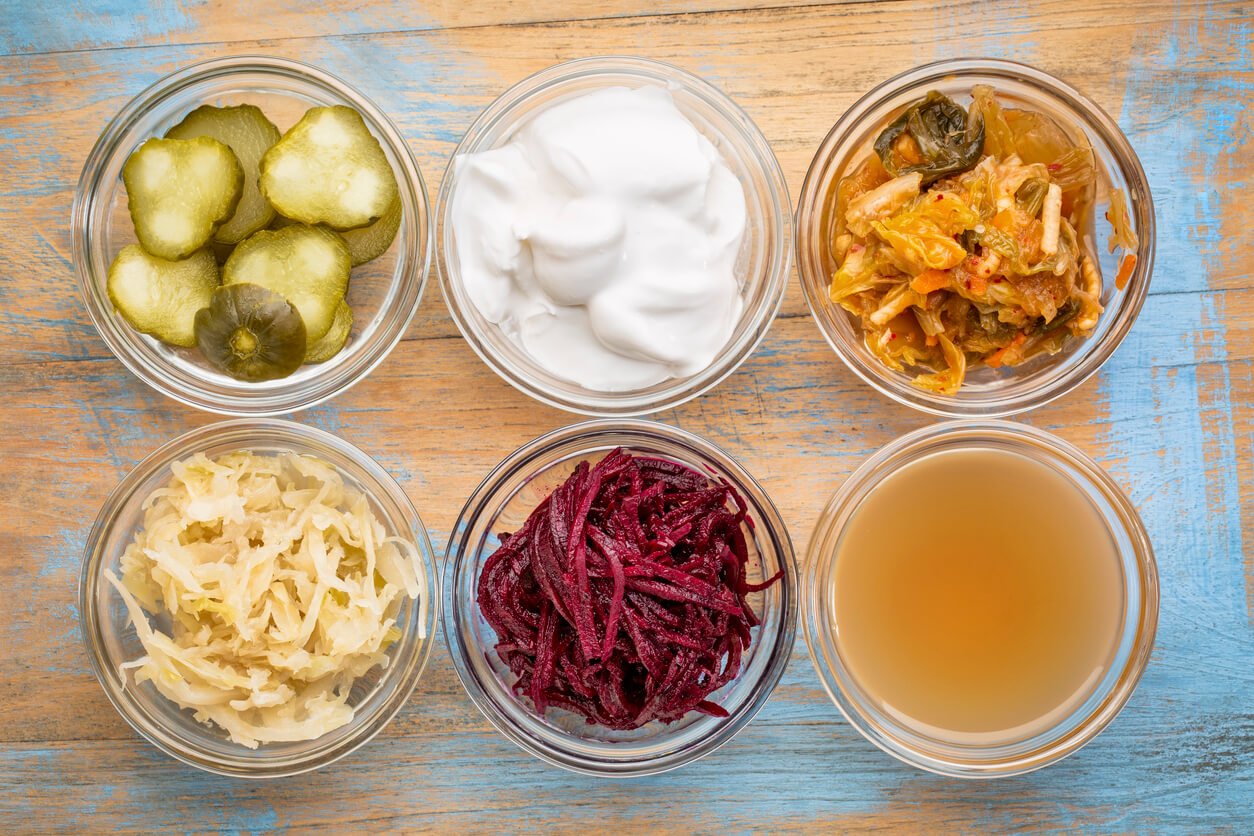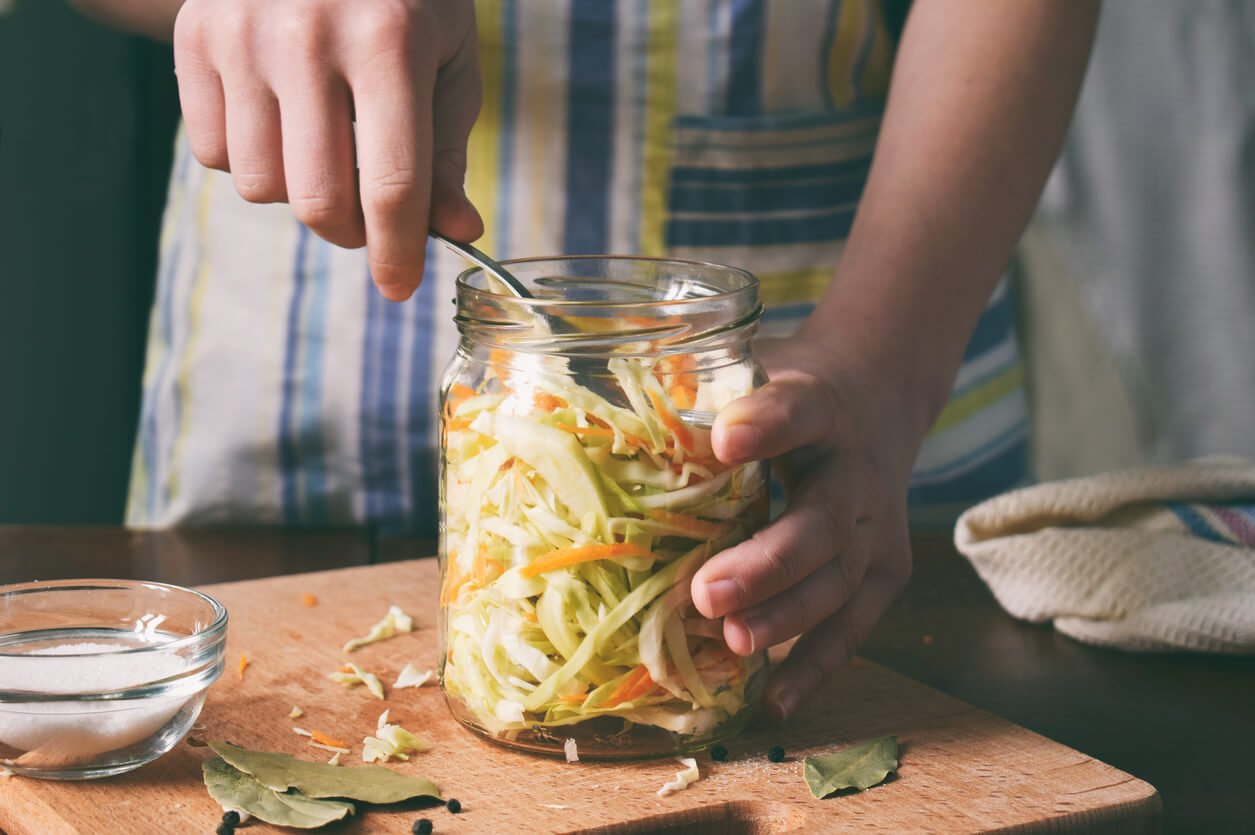Tell someone that they’re about to eat a substance that started out as a vegetable but was then processed by bacteria and yeast into an alcohol or acid, and you shouldn’t be surprised if they turn up their nose or run away screaming. The thought of those little critters messing with perfectly good food might sound more like a Transylvanian science experiment, complete with lightning strikes, than a healthy and delicious part of your diet.
But that’s exactly what fermentation is. Humans have harnessed and refined the process for a long time, and some of our favorite healthy foods are the result of this legacy of experimentation.
What Is Fermentation?
Fermentation is a way of preserving the flavor, texture, and quality of food as well as enhancing shelf-life.
It’s a natural process through which microorganisms like yeast and bacteria convert complex molecules into simple ones; for example carbohydrates — like starch and sugar — into alcohol or acids. Through the fermentation process, beneficial bacteria like probiotics are formed.
While some fermented foods can have strong odors (think bleu cheese and sauerkraut), the process of fermentation is very different from rotting, which is an uncontrolled decomposition leading to the growth of dangerous bacteria and molds (and which, eventually, turns food into dirt). While rot makes foods break down quickly, fermentation preserves them.
Types of Fermented Foods
There are many fermented foods at the grocery store, many of which you’ve probably seen – and some of which you may already enjoy.
Some of the most common fermented foods include:
- Sauerkraut, which is a type of fermented cabbage
- Kombucha, a fermented, effervescent tea that is often flavored
- Miso, a salty paste, usually made from soy, which is often used for soup and flavoring bases
- Kimchi, a traditional spicy Korean food made with cabbage and other veggies
- Pickled vegetables, like carrots, green beans, or cucumbers (note that these are high in sodium)
- Yogurt, which can have probiotics added and be made from dairy or from non-dairy milks based on foods like cashews, almonds, coconut, peas, and soy (stick to unsweetened varieties to avoid the high added sugar content of many commercial yogurts)
- Natto, a sticky food made from fermented soybeans (and something of an acquired taste!)
- Cheese, a fermented dairy product that can also be made using non-dairy options like cashews or almonds (check the label to see if they contain probiotic strains)
- Kefir, a cultured probiotic food that can be made from dairy, coconut, or water bases
And, in a slightly different category (because they’re cooked, so the microbes are killed), we have:
- Tempeh, a fermented soybean cake
- Sourdough bread, which is made by the natural fermentation of Lactobacilli and yeast
A Word About Alcoholic Fermentation
Alcoholic products, such as beer and wine, are also fermented. However, the effects of alcoholic beverages on the microbiome are quite different from the effects that other fermented foods offer. It’s true that many fermented foods do contain a small amount of alcohol, as a natural result of the fermentation process. But the quantity is minimal. For instance, kombucha typically contains 0.5% by volume or less, a small amount that allows most varieties to be labeled non-alcoholic.
When it comes to the microbiome, drinking fermented alcohol products like beer can lead to gut inflammation, intestinal hyperpermeability, and alcohol-induced oxidative stress. There’s a reason the word “intoxicated” contains the word “toxic” – alcohol can kill microorganisms in our microbiome in the same way it is used in medical practice to sterilize skin and needles.
On the other hand, fermented foods like kombucha, yogurt, kimchi, or sauerkraut can have positive effects on your microbiome, like improving your immunity, reducing how long you’re sick, improving nutritional absorption, decreasing inflammation, and alleviating upset stomach and diarrhea. While alcoholic beverages fall under the broad category of fermented foods, for the purpose of simplicity this article focuses on the fermented foods that have little or no alcohol.
5 Health Benefits of Fermented Foods
Why might you want to make fermented foods a part of your regular diet? Here are five good reasons. Some of the probiotic-related studies cited below have focussed on probiotics taken in the form of supplements (because supplements are more profitable for manufacturers, and easier for researchers to measure). While we don’t know with certainty if fermented foods that are rich in these same probiotics would generate the same results, it stands to reason that eating fermented foods that are rich in probiotics can convey many of (if not more of) the same benefits.
1. They help rebuild gut flora with good bacteria
Fermented foods are rich in a diverse array of probiotic microbes that can be friendly to your gut. They’re known for helping keep you regular, reducing diarrhea, and improving digestion. The probiotics in fermented foods work to promote a healthy microbial diversity in your gut microbiome, which reduces gas and bloating.
A 2012 meta-analysis published in PLoS One looked at which digestive conditions saw the most benefit from probiotics, such as those found in fermented foods. The researchers concluded that infectious diarrhea, irritable bowel syndrome, Helicobacter pylori, Clostridium difficile, and antibiotic-associated diarrhea were among the conditions positively impacted by probiotics.
Other research concurs that probiotics can be beneficial for people suffering from inflammatory bowel diseases like Crohn’s disease, as well as irritable bowel syndrome.
2. The probiotics in fermented foods can be beneficial to your immune system
Next time you’re sick, you might want to consider eating some probiotics.
A 2014 meta-analysis published in the British Journal of Nutrition looked at twenty randomized controlled trials on the impact of Lactobacillus and Bifidobacterium (probiotic strains often found in fermented foods like yogurt, sauerkraut, and kimchi) on the duration of acute respiratory illnesses. The researchers concluded that probiotics can reduce the length of time that otherwise healthy kids and adults are sick.
In 2008, researchers published a remarkable study in the Journal of Clinical Gastroenterology. Several hundred healthy, adult volunteers were randomly divided into two groups. One of the groups took a probiotic/prebiotic blend daily for 90 days, during the height of flu season. The other group took a placebo for the same period of time. What do you think were the results? Those taking the probiotic/prebiotic supplement had a 75% reduced incidence of flu and flu-like respiratory illnesses, and a nearly 40% reduced incidence of colds.
In addition to probiotics, some fermented foods are abundant sources of essential vitamins and minerals that are good for your immunity. For instance kimchi is rich in vitamin A, vitamin C, and vitamin K, as well as in calcium, iron, and phosphorous, and selenium.
3. They may support your mental health
Leading-edge research is finding that your nervous system and your intestinal system are in constant communication. When one feels poor, so does the other. A healthy microbial balance, such as can be supported by fermented foods, can be good for your gut and, therefore, your brain.
In fact, a growing body of research indicates that fermented foods may be protective against depression, anxiety, and other mental health challenges.
As we know, fermented foods are high in probiotics. How do probiotics affect your mental health? A 2016 review published in the Journal of Neurogastroenterology and Motility looked at 38 human and animal studies, finding that probiotics — mostly Bifidobacterium longum, Bifidobacterium breve, Bifidobacterium infantis, Lactobacillus helveticus, and Lactobacillus rhamnosus — can be beneficial for people with depression, anxiety, obsessive-compulsive disorder, autism spectrum disorder, and even memory impairments.
4. They may be good for your waistline
Abundant research affirms the health benefits of kimchi. It can be good for your immune system, for fighting aging and cancer, and perhaps most prominently of all, for supporting healthy weight loss. But one question persists. Kimchi is made of fermented vegetables and spices, which are known to be health-promoting even when they aren’t fermented. So are the benefits of fermented kimchi just a result of healthy raw ingredients, or does the fermentation contribute something special?
Seeking to answer this question, in 2011 researchers published a study in Nutrition Research. In the study, 22 overweight and obese adults were randomly assigned to two 4-week diet phases, during which they added either fresh or fermented kimchi to their diet. Measurements of body weight, body mass index, and body fat were taken. The findings showed that eating fermented kimchi had more positive impacts on health than fresh (unfermented) kimchi. Fermented kimchi was associated with a significant decrease in waist to hip ratio, and body fat percentage.
In another 2014 study in the British Journal of Nutrition, women who took Lactobacillus rhamnosus (a probiotic found in many fermented foods) for three months, in addition to being on a weight loss diet, lost 50% more weight than those who followed the same diet program but didn’t take the probiotic.
Fermented foods may also reduce inflammation, which is an immune response that can trigger weight gain.
5. They may promote heart health
A 2011 study found that adults who consumed fermented kimchi saw a significant reduction in their fasting blood glucose, blood pressure, and total cholesterol levels — all important biomarkers for heart health. And researchers at the Pusan National University in Korea found that fermented kimchi could lower LDL cholesterol levels and reduce the risk of strokes and heart attacks.
How to Ferment Foods
If you’re interested in fermenting your own foods at home, it’s a surprisingly straightforward (and inexpensive) process. Two of the easiest and most satisfying options are homemade sauerkraut and kimchi. Sauerkraut and kimchi are very similar, as both are essentially lacto-fermented cabbage. Sauerkraut uses white cabbage (the most common type of cabbage in North America and Europe) and is often spiced with caraway seeds. Kimchi starts with chinese cabbage and it is usually spiced with chillies or chili paste and garlic. While both sauerkraut and kimchi can have a variety of seasonings and spices added, kimchi is typically spicier.
Fermenting Sauerkraut
Here are the basic steps for fermenting your own sauerkraut (or kimchi) at home.
- Sterilize all of your equipment, including your jar (mason jars with screw top lids work well). If you sterilize equipment with boiling water or in a dishwasher, make sure to let everything cool to room temperature before you start adding your ingredients.
- Finely grate your cabbage (or chinese cabbage) and add it to a large mixing bowl, along with canning and pickling salt (about 1 ½ tsp salt for every 8 cups of grated cabbage is a good ratio). With clean hands, massage these together while the cabbage softens and shrinks.
- Add other ingredients (e.g., shredded beets and carrots, seasonings like garlic, chilies, or ginger) to the cabbage mixture and use your hands again to massage them together.
- Place your sauerkraut mixture into the sterilized mason jar, pressing it down firmly. Liquid should rise up to the top, but if it doesn’t cover the top, add some filtered water.
- Screw on your lid, leaving 1-2 inches of room between the lid and the top of your sauerkraut so that it has room to expand as it ferments.
- Keep your sauerkraut at room temperature, around 65°F, for best results. Fermentation can take anywhere from 24 hours to 2 weeks.
- Once per day, open the lid to your jar to release any built up carbon dioxide. Use a clean spoon to press the sauerkraut back underneath the liquid if it has risen.
- When your sauerkraut or kimchi has reached your desired level of fermentation and flavor, it can be kept in the fridge for 3-6 months.
Fermenting Yogurt
To make your own fermented yogurt at home, follow these steps:
Note: This works best if you use a yogurt maker (or make it in the oven with the oven light on) and a yogurt starter culture.
- Sterilize all of your equipment, either by using boiling water or running them through the dishwasher. Let everything cool to room temperature before using.
- Use a thermometer and add full-fat “milk” (can be soy, coconut, or other varieties) to a large pot and heat it to 180°F. Stir gently so that it doesn’t start creating a film or burning on the bottom. Note that you can also add a thickener during this step, like agar agar powder, if desired.
- Remove the milk from the heat source and let it cool to 110-115°F.
- Add the starter culture to your warm milk and whisk it until dissolved.
- Pour your yogurt mixture into yogurt making containers. Leave it here for 5-10 hours at 110-115°F. Many ovens reach and stay at this temperature with the oven door closed and the oven light left on. Some people also find that a heating pad, left on inside a sleeping bag, creates the desired temperature. The longer you leave your yogurt fermenting, the thicker and more tart tasting it will become.
- When the desired thickness is reached, transfer your yogurt to the refrigerator for 2-3 hours until it’s cold.
- Store your yogurt in the fridge for up to 2 weeks.
- Note: If you have a yogurt maker, the process may be simpler, and you should follow the instructions that come with it.
Safety Concerns With Fermented Foods
Although fermented foods offer many health benefits, it’s important to be aware of potential safety concerns when making or buying them.
Overall, there’s less risk of contamination in fermented foods as compared to canned foods. However, bad bacteria and mold can grow if the fermentation isn’t done properly.
For instance, exposing your ferment to too much air or an improper growth environment can lead to yeast overgrowth or even to rotting. Sometimes this occurs if you start with an unclean container, don’t use an adequate amount of salt, or ferment at the wrong temperature.
To avoid these mistakes, it’s important to keep your ferment at the right temperature for optimal growth, and to add the right amount of salt or brine. If using salt, “canning and pickling salt” is usually what’s recommended. It is coarser than table salt. An ideal temperature for most ferments (other than yogurt and kefir) is between 68°F and 75°F, above which spoilage is a higher risk.
Foodborne illnesses from consuming fermented foods is not common, though, and when it does occur, it mainly happens after consuming animal-based fermented foods.
Side Effects of Eating Fermented Foods
If you’re new to eating fermented foods, or you eat them somewhat sporadically, there are several potential side effects you may experience.
Some of the most common side effects include:
- Bloating
- Diarrhea
- Constipation
- Gas
- Indigestion
One reason you may be hit with side effects is if you introduce fermented foods too quickly. Some people are sensitive to fermented foods, and need a slow initial introduction. If this is the case for you, you might want to start with a tablespoon of sauerkraut, instead of downing ½ cup of it. Work your way up slowly and your body – and the trillions of microorganisms in your gut – will likely adapt.
Another reason could be that you’re eating them alongside protein-rich foods. Protein takes longer to digest, so when it’s eaten at the same time as a gut-friendly fermented food, this can in some cases lead to gas and bloating.
It’s also possible that you could have a food or histamine intolerance, or that you’re sensitive to FODMAPs (if you’re studying to appear on Jeopardy, that stands for Fermentable Oligo-, Di-, Mono-saccharides And Polyols) — short-chain carbohydrates like fructose and lactose that are often found in fermented foods. Kombucha, kimchi, and sauerkraut are high in FODMAPs, and may be difficult for someone with a sensitivity to tolerate.
Be Mindful of the Salt in Fermented Foods
Keep in mind, too, that many fermented foods, like kimchi, miso, and sauerkraut, are high in sodium. For example, 4 Tablespoons of sauerkraut contain nearly 400 mg of sodium, or almost 20% of your Daily Value, and just 1 Tablespoon of miso has 775 mg of sodium. Regularly eating a lot of salty fermented foods could be problematic especially for people with high blood pressure. Salty foods can also dehydrate you pretty quickly, and cause your body to excrete more calcium.
To reap the benefits without overdoing the sodium, you can use things like sauerkraut and kimchi as a salt source for flavoring many meals. For instance, they can be added to wraps and cold pasta dishes, or to top warm dishes like burritos and casseroles. Just don’t cook them so that the live probiotics won’t be killed off by excess heat.
Fermented Foods Recipes
If you’re interested in giving some homemade fermented foods a shot, here are some great recipes to try.
Homemade Sauerkraut by Wellness Mama – This is a simple, countertop recipe that only uses 3 ingredients and takes 30 minutes to prepare (and then 2-5 weeks to ferment).
5 Simple Fermented Carrot Sticks Recipes by Holly at MakeSauerkraut! – These tasty recipes are a great way to give fermenting a try at home. With five flavor options, as well as instructions for creating a 2% brine solution, you’ll be confidently fermenting in no time.
Simple Vegan Cashew Yogurt by Simple Vegan Blog – This recipe proves that you don’t need high-sugar, dairy-based yogurt to enjoy the probiotic benefits of this fermented food. Using non-dairy ingredients and probiotic supplements, this easy recipe is healthy and delicious.
Add Fermented Foods to Your Diet
The best way to get the most benefit from eating fermented foods is to incorporate a variety of them into your diet. You may find that you like some more than others, or that certain ones have specific uses that you enjoy. Because fermentation has been around for such a long time, different fermented foods can give a “signature” cultural flavor to an otherwise neutral dish. Even small amounts can have an outsized influence on your taste buds: Just a few of the Fermented Firecracker Carrot Sticks from MakeSauerkraut!, featuring jalapeno peppers and oregano, will give your salad or wrap a distinctive “South of the Border” vibe. A couple tablespoons of miso can turn your vegetable noodle soup from Eastern European to Asian.
If you’re feeling adventurous, you can even make your own fermented foods at home, starting with the instructions and recipes in this article. For extra drama, wait for thunderstorms and find a kitchen helper to say “Yes, Dr. Frankenstein” and “I do believe this just might work” at critical junctures in the process.
Whether you buy ready-made or ferment your own, the potential benefits to your health are worth giving some new fermented foods a try. Not only may you find them delicious, but about 50 trillion of your little buddies will consider them a wonderful treat. And it’s always a good idea to trust your gut!
Tell us in the comments:
- What fermented foods do you like to eat?
- Have you ever made your own fermented foods?
Featured Image: iStock.com/etorres69









